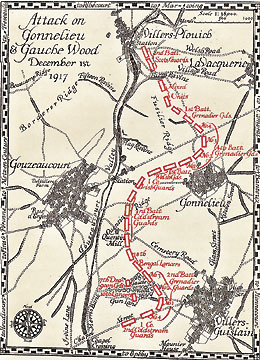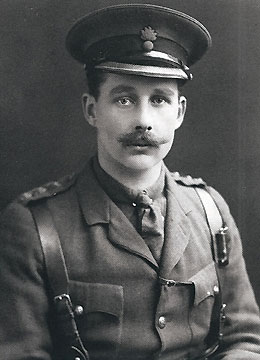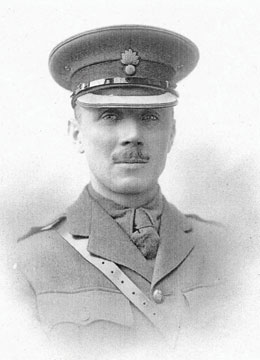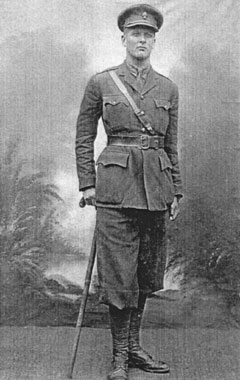|
THE CAPTURE OF GAUCHE WOOD - 1st DECEMBER 1917
by Major P A J Wright OBE
formerly Grenadier Guards
|
 Map of the attack on Gonnelieu and Gauche Wood
Map of the attack on Gonnelieu and Gauche Wood |
After the initial assault by the Allies in the Battle of Cambrai, when 381 tanks were used en masse for the first time, the Germans counter attacked and overwhelmed the village of Gouzeaucourt on 30th November 1917. It was recaptured on the same day by 1st Guards Brigade consisting of 2nd Battalion Grenadier Guards and 2nd and 3rd Battalions Coldstream Guards. 1st Guards Brigade, commanded by Brigadier General Claude Champion de Crespigny, was next ordered to recapture the Quentin Ridge, which included Gauche Wood. 2nd Battalion Grenadier Guards, commanded by Lieutenant Colonel G E Rasch DSO, was to be the right assault battalion of the brigade with the dismounted 18th Bengal Lancers on its right.
Rasch was directed to take Gauche Wood at dawn on Saturday 1st December. The objective was the eastern end of the wood, which measured approximately 700 by 300 yards with tall trees and undergrowth. It commanded the whole area including the village of Villers Guislain. The German strength in the wood was thought to be about a company. Orders were issued for 1 and 3 Companies to lead the attack with 2 and 4 Companies in support. Rasch went forward with the company commanders to reconnoitre a sunken road about 1200 yards from the objective, from where the assault would be launched. The battalion marched off at 4.30am after breakfast and all companies were in position by 6.00am. A dozen tanks were to precede the attack by 400 yards and provide support, but their arrival was delayed.
At 6.30am the artillery fire plan began, and, having waited fifteen minutes with no sign of the tanks, Rasch ordered the companies to advance. At this stage in the war, large numbers of all ranks were left behind whenever offensive operations were undertaken and the companies’ average strength was 32 other ranks per platoon and three officers per company, none above the rank of lieutenant. Lieutenant F A M Browning, commanding 2 Company and Lieutenant G R Westmacott, commanding 4 Company on his right, watched the leading companies advance in extended order, each in two lines of two platoons. They moved at a great pace across the intervening grassland, which rose in a gentle slope up to the wood. It was misty, the light was poor and initially things went well. Although the men came under heavy machine gun fire from the edge of the wood, few were hit at this stage.

Lieutenant Colonel G E Rasch DSO |

2nd Lieutenant S A Pearson |
Lieutenant J C Cornforth MC was commanding 1 Company on the left and 3 Company on the right was commanded by Lieutenant F A Acland MC. As they came within 300 yards of the fringe of the wood casualties became heavier from a concealed line of ten machine guns. At 7.00am, Cornforth was shot in the leg and lost both his platoon commanders. 2nd Lieutenant S H Pearson was shot through the head by a sniper leading his platoon into the wood. 2nd Lieutenant P A A Harbord MC, was wounded while rushing a machine gun, and died later in the day. Acland and both his platoon commanders, Lieutenant F A Magnay and Lieutenant R Y T Kendal were also wounded. In the wood the Germans were forced back in hand to hand bayonet fighting. However, casualties began to mount from snipers amongst the trees. Lance Sergeant H Ward MM was shot in the head as he entered the wood. By the time the objective was reached, Browning was in command of the remaining men of the leading two companies as well as his own.
The men had not been trained in close country fighting; however, the discipline in the battalion and skill and resourcefulness of the NCOs meant that each platoon could be relied upon to act intelligently despite the loss of its commander. When his platoon commander was wounded, Sergeant A Spowage, took charge and led the platoon forward under heavy fire, capturing several machine guns and killing their crews. Seeing the flank of the battalion was vulnerable, he led his platoon on his own initiative to fill the gap. He was killed in action three months later. Sergeant J Bosworth MM commanded a platoon when all the officers in 3 Company became casualties. He succeeded in reaching the objective, but died shortly afterwards from his wounds.
 Looking towards Gauche Wood and Villers Guislain from Gouzeaucourt
Looking towards Gauche Wood and Villers Guislain from Gouzeaucourt |
Lance Sergeant C Lamplugh captured a machine gun and its crew during the attack and, with the officers in his company all casualties, led half the company to the objective and organised the consolidation under heavy fire. Lance Corporal A E McCaffery commanded a leading platoon during the attack, and when the objective had been captured, he found there was a gap of 400 yards on his left. He deployed his men to cover the gap by fire and, using his Lewis gunners, put out of action and captured three enemy field guns.
On reaching the wood, Westmacott swung his company round to cover the exposed right flank and was able to repel a counter attack of about 70 enemy, killing all but five, who were taken prisoner. Private H Gladders rushed his Lewis gun over to the threatened flank and inflicted heavy casualties on the enemy single handed. At about 7.45am a further 60 Germans attacked and were defeated in hand to hand fighting. Westmacott found himself and Lieutenant F P Loftus to be the only officers on the flank. He contacted Browning and between them they reorganised the battalion in a defensive position, dug-in beyond the forward edge of the wood, shortly before the Germans shelled it intensively.
About this time, the 18th Lancers appeared advancing up the hill under fire, together with the long-awaited tanks. A Grenadier officer later wrote: ‘Everyone admired your advance as you came up that ridge, because the Hun was throwing a great deal of stuff at you, but your fellows came on without turning a hair.’ During the fighting in the wood, the two regiments became intertwined with guardsmen being commanded by Lancer officers. The tanks were attracting heavy shelling directed from a German aeroplane. Tank A25, on leaving the wood, was hit in the turret by a shell and the commander, 2nd Lieutenant E F de Fay, and driver, Private Voice, were killed and two gunners wounded. Other crews, whose tanks had been knocked out, detached their Lewis guns and assisted on the exposed flank.
By now, Lieutenants F H J Drummond MC and W H S Dent had been wounded and Westmacott encountered Lieutenant F H G Layland-Barrett MC of 2 Company with a shrapnel splinter in the face. He dressed the wound and asked him to report the disposition of the companies to Battalion Headquarters. At 10.00am, Rasch arrived and went round the line. He asked Lieutenant Colonel E C Corbyn, commanding the 18th Lancers to form a reserve in the centre of the wood. Corbyn was killed by shellfire that afternoon. Rasch later wrote: ‘The dash and fighting spirit of all ranks of this Regiment and help and experience which Colonel Corbyn gave at that critical moment made the greatest impression on the Battalion.’ On Rasch’s return, Captain G C F Harcourt-Vernon, his Second in Command, went forward with ammunition and a company of 2nd Battalion Coldstream Guards under Captain H Brierly.

2nd Lieutenant P A A Harbord MC
|

The silver figure of a mounted 18th Lancer
|
At 9.00pm that evening the battalion handed over and withdrew to Gouzeaucourt Wood. In total, 25 NCOs and other ranks were killed, 115 wounded and 11 missing. Among twelve Company Officers, one was killed, one died of wounds, and seven were wounded. Three field guns and twelve machine guns in addition to many prisoners were captured. Westmacott and Browning were both awarded the DSO and Spowage, Lamplugh, McCaffery and Gladders were each awarded the DCM. One officer in the 18th Lancers was awarded a DSO and another an MC. Browning was profoundly affected by the confusion and carnage of Gauche Wood. For the rest of his life he would have recurrent nightmares and awake shouting.
Describing the battle, an officer of the 18th Lancers wrote: ‘I have now seen His Majesty’s Guards in action and fought alongside them. They can die like gentlemen without a groan. Four of our men were carrying a Guardsman who appeared to be suffering considerably. I asked him who he was, and he instinctively straightened himself as best he could and said, “A Grenadier” his tone implying how proud he was to be one.’ The link between the two regiments was marked by an exchange of gifts. The battalion was presented with the silver figure of a lancer and in return they gave the 18th Lancers a silver bugle which remains in the Officers Mess of the Pakistani Regiment, the 19th Lancers, and the inheritors of the Indian Army regiment. The link continues to this day with an exchange of greetings on 1st December, the day Gauche Wood was captured. |
|






